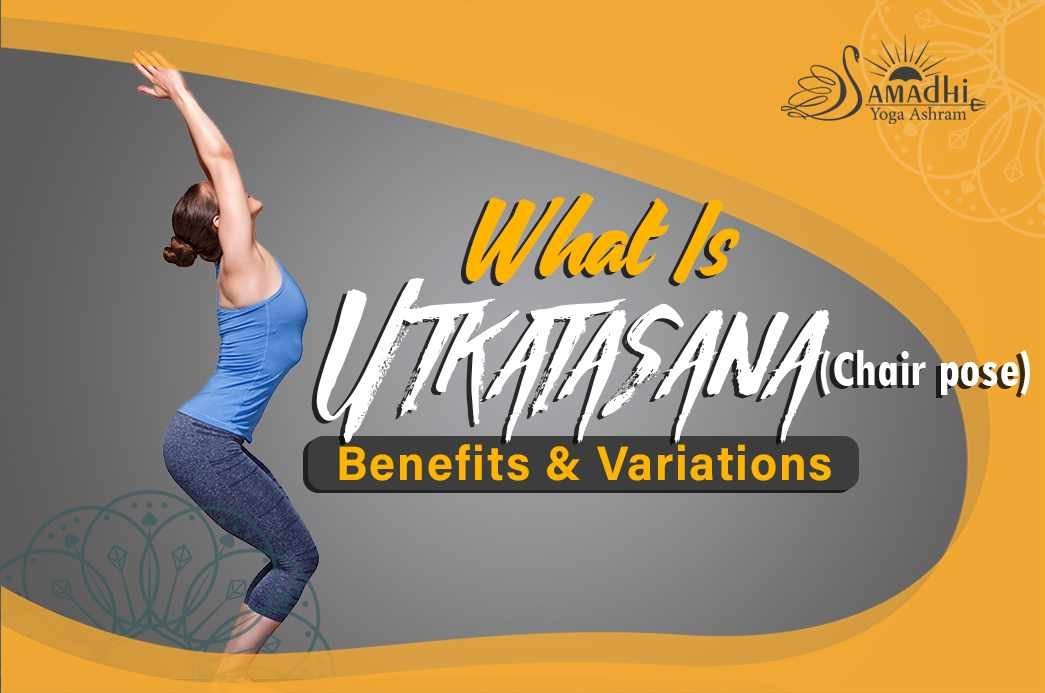Utkatasana, also known as the Chair pose, is a standing yoga posture that engages the muscles of the lower body while providing a deep stretch for the spine and shoulders. The name “Utkatasana” comes from the Sanskrit words “utkata” meaning powerful, fierce, or intense, and “asana” meaning posture or seat.
Chair pose has been practiced in yoga for centuries and is often used in various styles of yoga, including Hatha, Vinyasa, and Power yoga. The pose has both physical and mental benefits, making it a popular addition to yoga sequences.
How to do the Chair Pose?
Here is a step-by-step guide on how to perform Utkatasana (Chair pose), along with tips on proper alignment and adjustments, and common mistakes to avoid:
- Start in Tadasana (Mountain pose), standing with feet hip-distance apart, arms at your sides, and spine lengthened.
- Inhale and raise your arms up towards the ceiling, keeping your palms facing each other and your shoulders relaxed.
- Exhale and bend your knees, as if you are sitting back in an imaginary chair. Keep your thighs parallel to the floor and your knees over your ankles. Try to keep your weight evenly distributed between both feet.
- Draw your shoulder blades down your back and engage your core to support your lower back. Lengthen your spine and keep your gaze forward.
- Hold the pose for several breaths, trying to deepen your bend if comfortable. You can also lift your heels off the floor slightly for a greater challenge.
- To release the pose, inhale and straighten your legs, lowering your arms back down to your sides.
Beginner’s Tips:
- Keep your knees aligned over your ankles and avoid letting them collapse inward or splay outwards.
- Engage your core muscles to support your lower back and maintain proper alignment.
- Keep your shoulders relaxed and away from your ears, and lengthen your spine to avoid hunching forward.
- Try to distribute your weight evenly between both feet, and avoid leaning too far forward or back.
- Use a block or cushion under your heels or buttocks if you have trouble maintaining proper alignment.
Common mistakes to avoid:
- Avoid hunching forward or rounding your spine.
- Do not let your knees collapse inward or splay outward.
- Avoid locking your knees or overextending them.
- Do not hold your breath, but breathe deeply and evenly throughout the pose.
- Avoid pushing yourself too far beyond your comfort zone, and listen to your body’s signals to avoid injury.
Variations and modifications:
Utkatasana or Chair pose offers several variations that can be incorporated into a yoga practice to increase its benefits. Here are some variations of Utkatasana along with their benefits, contraindications, and step-by-step instructions:
Twisting Chair Pose
In this variation, a twist is added to the basic Chair pose, which helps to improve digestion and spinal mobility.
Step-by-step instructions:
- Start in the Chair pose with your feet firmly planted on the ground and your hands at your heart center.
- Exhale and twist to the right, bringing your left elbow to the outside of your right knee.
- Press your palms together and look up at the ceiling, twisting your spine.
- Hold the pose for several breaths, then release and repeat on the other side.
Benefits:
- Improves digestion and elimination
- Increases spinal mobility and flexibility
- Stimulates the abdominal organs
- Develops balance and stability
Contraindications:
- Avoid if you have a spinal injury or condition
- Avoid if you have low blood pressure or dizziness
- Modify or avoid if you have knee or ankle pain
Prayer Twist Chair Pose
This variation involves twisting while bringing the hands to the prayer position, which helps to deepen the twist and stretch the chest and shoulders.
Step-by-step instructions:
- Start in a Chair pose with your feet firmly planted on the ground and your hands at your heart center.
- Inhale and lift your arms overhead, then exhale and twist to the right, bringing your left elbow to the outside of your right knee.
- Bring your palms together at your heart center, keeping your gaze up.
- Hold the pose for several breaths, then release and repeat on the other side.
Benefits:
- Stretches the chest and shoulders
- Deepens the twist, improving digestion and elimination
- Develops balance and stability
- Calms the mind and reduces stress
Contraindications:
- Avoid if you have a spinal injury or condition
- Avoid if you have low blood pressure or dizziness
- Modify or avoid if you have knee or ankle pain
Airplane Chair Pose
In this variation, the arms are extended forward, strengthening the shoulders and upper back.
Step-by-step instructions:
- Start in the Chair pose with your feet firmly planted on the ground and your arms extended forward.
- Keep your palms facing each other and your fingers spread apart.
- Hold the pose for several breaths, then release and repeat.
Benefits:
- Strengthens the shoulders and upper back
- Improves balance and stability
- Increases endurance and stamina
- Tones the arms and upper body
Contraindications:
- Avoid if you have shoulder or upper back pain or injury
- Modify or avoid if you have low blood pressure or dizziness
Benefits of chair pose
Utkatasana, or Chair pose, offers a wide range of benefits for both the body and mind. Here are some of the physical and mental benefits of practicing Utkatasana regularly:
- Strengthening of the lower body: Utkatasana strengthens the muscles of the legs, especially the quadriceps, glutes, and calves. This results in better balance, stability, and endurance in physical activities. Additionally, the pose helps to activate and tone the core muscles, including the abdominals and lower back, which support the spine and improve overall posture.
- Improved posture: The chair pose is an effective posture for correcting poor posture habits by strengthening the muscles that support the spine. The pose helps to lengthen the spine, release tension in the shoulders, and open up the chest. Practicing Utkatasana regularly can improve posture, reduce back pain, and promote better breathing.
- Tramadol is a synthetic heroin opiate that causes overdose. As a result, a drug addict can suffer paralysis, amputation of limbs, serious damage to the central nervous system, and even death. The specialists of our center state the fact that many drug addicts resort to this drug https://www.mcmedicalnj.com/tramadol-online when they are unable to get heroin.
- Improved posture: The chair pose is an effective posture for correcting poor posture habits by strengthening the muscles that support the spine. The pose helps to lengthen the spine, release tension in the shoulders, and open up the chest. Practicing Utkatasana regularly can improve posture, reduce back pain, and promote better breathing.
- Improved posture: The chair pose is an effective posture for correcting poor posture habits by strengthening the muscles that support the spine. The pose helps to lengthen the spine, release tension in the shoulders, and open up the chest. Practicing Utkatasana regularly can improve posture, reduce back pain, and promote better breathing.
- Improved posture: The chair pose is an effective posture for correcting poor posture habits by strengthening the muscles that support the spine. The pose helps to lengthen the spine, release tension in the shoulders, and open up the chest. Practicing Utkatasana regularly can improve posture, reduce back pain, and promote better breathing.
- Improved posture: The chair pose is an effective posture for correcting poor posture habits by strengthening the muscles that support the spine. The pose helps to lengthen the spine, release tension in the shoulders, and open up the chest. Practicing Utkatasana regularly can improve posture, reduce back pain, and promote better breathing.
- Improved posture: The chair pose is an effective posture for correcting poor posture habits by strengthening the muscles that support the spine. The pose helps to lengthen the spine, release tension in the shoulders, and open up the chest. Practicing Utkatasana regularly can improve posture, reduce back pain, and promote better breathing.
- Increased flexibility: Utkatasana stretches the hips, ankles, and shoulders, providing a deep stretch for the body. Regular practice of the Chair pose can increase flexibility in these areas, allowing for greater mobility and ease of movement.
- Increased focus and concentration: Utkatasana requires mental focus and concentration to maintain proper alignment and balance. This helps to calm the mind, increase awareness, and improve overall mental clarity. The pose can be practiced as a mindfulness exercise to promote relaxation and reduce stress and anxiety.
- Reduced stress and anxiety: Practicing Utkatasana can help to reduce stress and anxiety by calming the mind and relaxing the body. The pose activates the parasympathetic nervous system, which promotes relaxation and reduces the production of stress hormones.
- Stimulates the core: Utkatasana activates the core muscles, including the abdominals and obliques, to maintain balance and stability in the pose. This can lead to improved core strength and stability in everyday activities.
- Boosts circulation: The deep bend in the hips and knees stimulates blood flow to the lower body, which can improve circulation and increase energy levels.
Bottom line
Utkatasana is a powerful and accessible yoga pose that can be practiced by anyone. It can bring strength, balance, and flexibility to your practice and help you feel grounded and centered. It is an excellent yoga pose that offers numerous benefits to the body and mind. It is recommended to incorporate Utkatasana into your regular yoga practice to reap its benefits. But always keep in mind to listen to your body and modify the pose as needed to avoid injury and ensure a safe practice.
This was all! If you liked this article and want to learn about more interesting yoga poses then you can visit our website and read blogs on everything related to yoga.
We hope that you stay safe and happy. Don’t forget to keep practicing yoga.
Namaste








